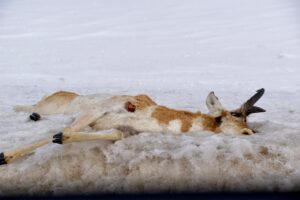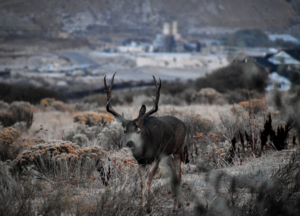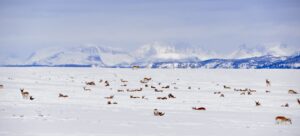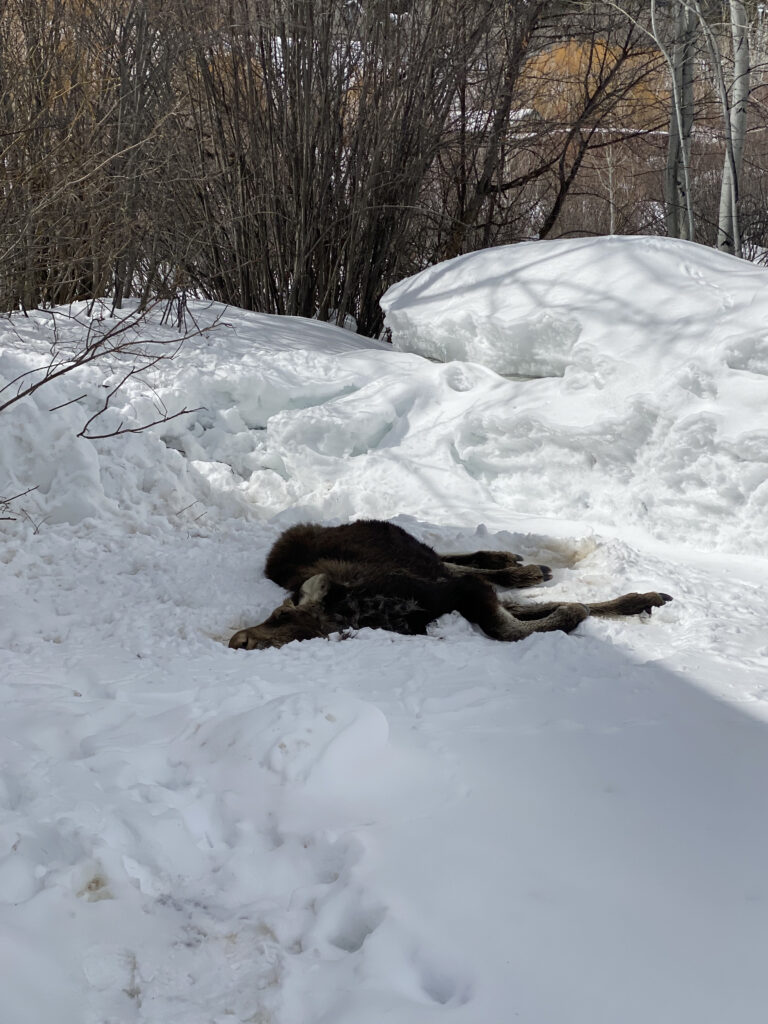By Hilary Turner
As you can imagine, it has been a difficult winter for many ungulates (hoofed mammals) in the Jackson Hole area. Nature Mappers have reported many dead animals, which have succumbed to vehicle collisions, predation, apparent malnutrition, and other unknown causes. Although it can be hard to watch, ungulates evolved with harsh winters. I spoke with wildlife biologists Aly Courtemanch, Ben Wise, and Bill Rudd about how our local ungulates are faring and how you can help.

While ungulate populations are well-evolved to endure die-off events over the long term, watching animals struggle through a long winter can be hard to watch.
As many of us have observed, this winter has been hard for many ungulates. Above average snow accumulations lingering longer than usual have been impactful. Smaller ungulates like mule deer can deal with periods of heavy snow and cold snaps, but according to Bill Rudd, what makes a winter especially hard for them is the seasons’ length. This winter, snow started in November and has continued relentlessly. Some of the largest snow accumulations of the winter have come in late-March, making things hard on smaller-bodied ungulates like deer and bighorn sheep, according to Aly Courtemanch. Too, the diel thaw-freeze cycles that occur this time of year exacerbate things for ungulates because a thick ice crust develops, making it hard for ungulates to paw through to snow-covered forage. Deep, crusty snow also forces animals into areas where they are forced to interface with humans, increasing the potential for wildlife-vehicle collisions and other conflicts.

Data from these 200 mule deer in the Wyoming Range show that fawn mortality currently approaches 90% and adult doe mortality approaches 40%.
A subset of the estimated 28,000 mule deer that winter between Evanston and Pinedale and summer in the Wyoming Range have been radio-collared for study by WGFD. Ben Wise shared that data from these 200 animals show that fawn mortality currently approaches 90% and adult doe mortality approaches 40%. Average fawn mortality is estimated to be 20-25% in milder winters. While no collars are deployed in Jackson, Wise has received daily phone calls about dead deer, especially fawns. He explained that fawns are the most resource-limited members of local deer populations and therefore, it is unsurprising that they are the first to succumb to the harsh conditions. However, not all is lost. Wise reminds us that these animals evolved with harsh winters and populations can handle it. Those animals that survive the winter will have more resources per animal, come summer, and will produce healthier fawns. In other words, there may be fewer animals on the landscape, but they will be in better condition.

As many as 600 Wyoming pronghorn are known to have died from disease caused by the bacteria Mycoplasma bovis, and many more will likely die as the bacteria works its way through the herd and the long winter wears on.
Pronghorn are also experiencing large die-offs in the Pinedale area. A combination of severe winter conditions that make forage inaccessible and a disease outbreak are negatively impacting them. The herd of approximately 20,000 pronghorn wintering in the Green River Basin is actually comprised of animals that summer in several locations, but some of these animals travel the famous Path of the Pronghorn, migrating into Grand Teton National Park each summer. Courtemanch and Rudd both indicated that biologists will have to wait until animals return to summer range to understand the true impacts of winter and disease on the GTNP population. As many as 600 animals are known to have died from disease caused by the bacteria Mycoplasma bovis, and many more will likely die as the bacteria works its way through the herd and the long winter wears on. Courtemanch indicates that the bacteria is rare in wildlife, but when it reaches pronghorn, it is extremely lethal.

Moose are likely faring better than pronghorn and mule deer this winter, however, well-intentioned artificial feeding can be counter productive. It is also prohibited and enforced by Teton County.
Moose, Courtemanch reminded me, are adapted to cold climates and harsh conditions. They thrive in cold temps and deep snow. Early snow falls may have helped them by shortening the winter tick questing season, when ticks seek moose hosts. Nature Mappers and wildlife biologists alike have observed that moose winter coats are looking better than they have in the past couple of years, which might be due to lighter tick loads. As I spoke with Wise about winter conditions he joked, “moose are doing great!” However, moose are still vulnerable to wildlife-vehicle collisions, which have been the main cause of documented mortalities this winter. Cleared roads are enticing for easier movement and deep snow berms make it difficult for them to move out of the way quickly when vehicles appear. Additionally, feeding hay and other artificial resources is detrimental, particularly to moose. Moose gut biomes can be negatively impacted by things like hay and upset balance in the gut can lead to things like renal failure. In the case of a young bull that recently died in Wilson, Nature Mappers documented the moose drinking excessively, which is unusual this time of year, according to Wise. Most ungulates get the water they need through eating snow. Therefore, when an animal is seen drinking excessive amounts of water, it can be an indication of neurological issues or renal failure, which often happens when moose ingest artificial food sources, like hay, rather than the woody resources they should be ingesting this time of year.
When asked what humans can do to help animals through this brutal winter, all three biologists gave the same answer – Give them space!
- Leash your dog to help animals during the next few critical weeks. As ungulates burn through the last of their fat reserves, they cannot tolerate extra energy expenditure, such as that forced when dogs chase them. Even in areas where it is not required, leashing your dog may be the difference between life and death for a wintering ungulate.
- Respect winter closures to make a difference for ungulates. Critical areas are protected to help animals make it through the toughest part of the winter, which is right now.
- Even though we may be tempted to help wildlife by giving them some extra food, this is more detrimental than beneficial. To help wildlife this winter, do not feed them.
- Carry bear spray to protect yourself and animals. Animals that injure humans are often euthanized. You can prevent this by carrying bear spray to prevent a negative encounter with any animal.
- Give wildlife a brake, especially now. Slow down and scan borrow pits for wildlife to prevent mortality.
- Support agencies and organizations like WGFD and JHWF that are working to advance wildlife conservation over the long term.
